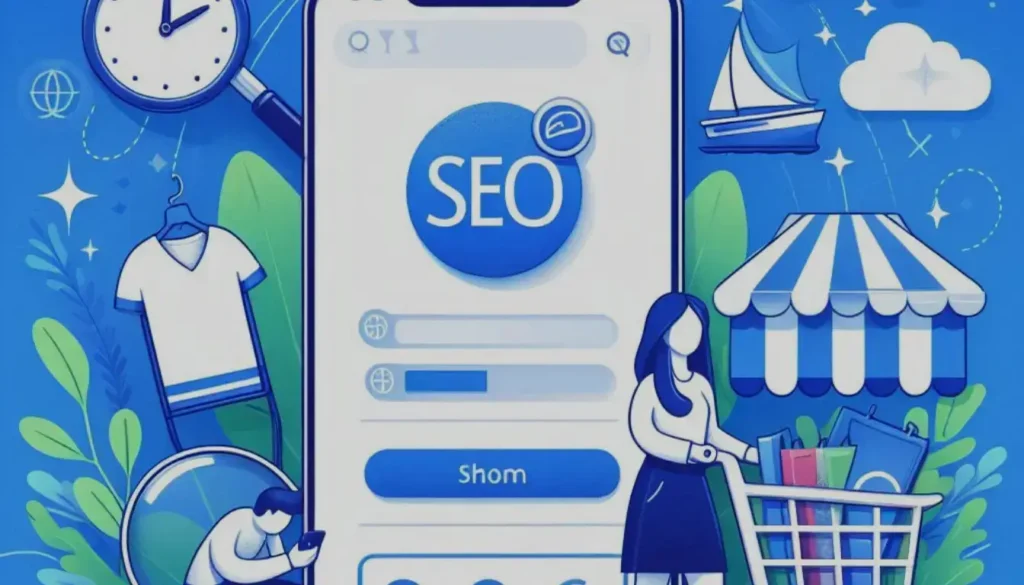“Can I Do SEO with Shopify? Here’s What You Need to Know The Best Guide in 2024”
Introduction: Understanding SEO with Shopify
SEO with Shopify is a crucial consideration for businesses looking to establish and expand their online presence through this popular eCommerce platform.
Shopify stands out as a leading choice for building and growing an online store, and many businesses are keen to understand how they can leverage it for effective search engine optimization.
The answer is a resounding yes. In this comprehensive guide, we will delve into the intricacies of SEO with Shopify, providing you with the best strategies to optimize your store and achieve high search engine rankings in 2024.
Why SEO with Shopify is Essential

The Role of SEO in eCommerce Success
SEO is crucial for any online business, and Shopify is no exception.
With millions of online stores competing for visibility, leveraging SEO with Shopify can make or break your success.
Effective SEO ensures that your Shopify store ranks higher in search results, driving organic traffic and increasing sales.
The Advantages of Shopify for SEO
Shopify offers a variety of built-in SEO features that make optimization straightforward.
From customizable title tags and meta descriptions to a user-friendly interface for adding alt text to images,
Shopify provides the tools you need to enhance your SEO efforts. Moreover, Shopify’s clean code and mobile-responsive themes contribute to better search engine rankings.
Key Strategies for SEO with Shopify
1. Keyword Research and Implementation
Understanding your target audience’s search behavior is the first step in mastering SEO with Shopify.
Utilize tools like Google Keyword Planner or Ahrefs to identify high-volume keywords related to your products.
Once you have your list of keywords, integrate them strategically into your product descriptions, title tags, meta descriptions, and URLs.
2. Optimizing Shopify Site Structure
A well-organized site structure enhances user experience and helps search engines crawl your site more effectively.
Organize your Shopify store with clear categories and subcategories, ensuring that every product is easy to find. Use a logical URL structure that includes your target keywords.
3. Enhancing On-Page SEO with Shopify
On-page SEO with Shopify involves optimizing individual product pages for search engines.
This includes writing unique and engaging product descriptions, optimizing images with alt text, and ensuring that your title tags and meta descriptions contain relevant keywords.
4. Utilizing Shopify’s Blogging Platform
Content is king when it comes to SEO with Shopify. Shopify’s built-in blogging platform allows you to create keyword-rich blog posts that drive traffic to your store.
Focus on creating valuable content that answers common questions related to your products or industry, and naturally incorporate your target keywords.
5. Mobile Optimization

With a significant portion of online shopping done via mobile devices, ensuring that your Shopify store is mobile-friendly is crucial.
Shopify’s responsive themes automatically adjust to different screen sizes, but it’s important to test your site on various devices to ensure optimal performance.
6. Leveraging Shopify Apps for SEO
Shopify offers a range of SEO apps that can enhance your optimization efforts. Tools like Yoast SEO, SEO Booster,
and Plug in SEO provide advanced features like automated meta tag generation, broken link detection, and more. These apps can save time and help you stay ahead of the competition.
Technical SEO with Shopify
1. Improving Site Speed
Site speed is a critical factor in SEO with Shopify. A faster site not only improves user experience but also contributes to higher search engine rankings.
Compress images, minimize the use of heavy scripts, and consider using a content delivery network (CDN) to improve your site’s loading times.
2. Setting Up Shopify’s Robots.txt and Sitemap
Shopify automatically generates a robots.txt file and sitemap, but it’s important to customize these settings to ensure that search engines are crawling and indexing your site effectively.
Exclude irrelevant pages from being crawled and submit your sitemap to Google Search Console.
Advanced SEO Techniques with Shopify
1. Schema Markup
Schema markup, also known as structured data, helps search engines understand the content on your Shopify store.
Implementing schema markup can enhance your search engine listings with rich snippets, such as product reviews, pricing, and availability, making your store stand out in search results.
2. Building Backlinks
Backlinks remain a powerful ranking factor in SEO with Shopify. Focus on building high-quality backlinks from reputable websites within your industry.
This can be achieved through guest blogging, influencer partnerships, and creating shareable content that others want to link to.
Conclusion: Mastering SEO with Shopify in 2024
In 2024, SEO with Shopify will continue to be a key driver of success for online businesses.
By implementing the strategies outlined in this guide, you can optimize your Shopify store for search engines, improve your rankings,
and ultimately, increase your sales. Stay ahead of the competition by continually refining your SEO approach and adapting to the ever-changing digital landscape.
Suggested Diagram: Shopify SEO Process
graph TD;
A[Start SEO with Shopify] --> B[Keyword Research]
B --> C[Site Structure Optimization]
C --> D[On-Page SEO]
D --> E[Content Creation]
E --> F[Mobile Optimization]
F --> G[Technical SEO]
G --> H[Advanced Techniques]
H --> I[Monitor & Refine]
This diagram provides a visual representation of the key steps involved in SEO with Shopify,
illustrating the process from initial keyword research to ongoing monitoring and refinement.
Frequently Asked Questions (FAQ) about SEO with Shopify
Frequently Asked Questions (FAQ) about SEO with Shopify
Can I do SEO with Shopify without coding knowledge?
Yes, Shopify is designed to be user-friendly, allowing you to implement SEO strategies without any coding knowledge. Most SEO tasks, such as editing meta tags,
creating alt text for images, and structuring URLs, can be done through Shopify’s intuitive interface.
However, for more advanced customizations, a basic understanding of HTML or hiring a developer might be beneficial.
How long does it take to see SEO results with Shopify?
SEO is a long-term strategy, and it can take anywhere from three to six months to start seeing significant results.
Factors such as the competitiveness of your niche, the quality of your SEO efforts, and the frequency of updates to your site content all play a role in how quickly you see results.
Is Shopify’s blogging platform effective for SEO?
Yes, Shopify’s blogging platform is highly effective for SEO. Regularly publishing high-quality,
keyword-rich content can help you rank for long-tail keywords and drive more organic traffic to your store.
Blog posts are also a great way to address customer questions and showcase your expertise in your niche.
Do Shopify apps help with SEO?
Yes, Shopify offers several apps that can enhance your SEO efforts.
Apps like Yoast SEO, SEO Booster, and Plug in SEO provide tools for optimizing meta tags, detecting broken links, and more.
These apps are particularly useful for automating and streamlining your SEO tasks.
What are the most important SEO factors for Shopify stores?
The most important SEO factors for Shopify stores include keyword optimization, site structure,
on-page SEO, mobile optimization, site speed, and backlinks. Each of these elements plays a crucial role in how well your store ranks in search engine results.
How do I optimize images for SEO on Shopify?
Optimizing images on Shopify involves several key practices: compressing images to reduce file size without losing quality, using descriptive and keyword-rich alt text,
and ensuring that image filenames are relevant to the content. These steps help improve page load times and provide additional context to search engines.
Can I change the URL structure of my Shopify store for better SEO?
Yes, Shopify allows you to customize your URL structure to make it more SEO-friendly. It’s important to use clear,
concise URLs that include relevant keywords. Avoid using unnecessary characters or numbers in your URLs, and ensure they are easy for both search engines and users to understand.
How important are backlinks for Shopify SEO?
Backlinks are crucial for improving your Shopify store’s authority and search engine rankings.
High-quality backlinks from reputable sites signal to search engines that your content is valuable and trustworthy.
Focus on building backlinks through guest blogging, partnerships, and creating shareable content.
Is Shopify good for international SEO?
Yes, Shopify supports international SEO by allowing you to set up multiple stores for different regions, optimize content for various languages,
and manage hreflang tags to indicate language and regional targeting. These features help you reach a global audience and rank well in different markets.
How can I monitor my SEO performance on Shopify?
You can monitor your SEO performance on Shopify using tools like Google Analytics,
Google Search Console, and various SEO apps available in the Shopify App Store.
These tools provide insights into traffic, keyword rankings, site speed, and other key SEO metrics, allowing you to track your progress and make data-driven decisions.






